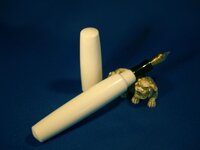If you have been turning pens for two years, I think that you have plenty of experience to take the next step. The biggest hurdle is how to cut the threads for the cap and barrel. There are basically three options here involving threads. Easiest and cheapest would be to go with single start basic threads. The downside to that most folks will say that you need about 4 or 5 turns of the cap to engage enough thread to ensure that it will not come off in your pocket.
The next level would be a multi start tap and die set. There have been two group buys now on this site for the multi start tap and die set. I got in on the first one. The cost was something just over $200 for the set, based on a group purchase of about 30 units. There may be some folks out there, who during this tough economic time, may be interested in selling theirs.
The best, but most costly and time consuming option, would be to buy a metal lathe with multi start threading capacity, and learning how to use it. That would give you much more flexibility, in that you could thread any size parts that you want, whereas with the tap and die set, you are limited to the 12mm size, the same as Berea's El Grande. This is the route that I would like to take eventually.
The other piece of equipment I would highly recommend is some type of collet chuck utilizing ER32 collets , which will allow you to hold the blank for drilling and tapping operations. You will also probably want to pick up a standard tap and die set from Harbor Freight, which will most likely supply most everything else you need for threading, such as the 10mm section threads.
That and a skew chisel or two pretty much covers the turning part. Oh wait, you will need a dial or digital caliper that measures in .001" increments. You will need this to size parts for threading, as well as many other operations. Harbor Freight is another good, cheap source for a dial caliper.
Now making your own metal center band and clips is another issue, which may require additional tools and skills. Clips can be scavenged from kits, or the ball type clip that I used on the pen you referenced above can be purchased from Elliot Landes
http://www.penmakers.com/used.html . There are several threads on this forum dedicated to cap bands, which explain various approaches to them.
I would highly suggest going through the entire "Advanced Pen Making" forum here, and reading every thread that pertains to kitless pens. That will give you a pretty good grounding on the subject. At least then you will know what specifically to ask in follow up.
One annoying feature of this forum's software, is that it only shows you one months worth of threads, so you need to go to the bottom of the page and set to show all of the threads from the beginning. This will give you a thirteen page index.
It can be very rewarding to go beyond the bounds of kits, but certain aspects can also be somewhat intimidating. It does require a willingness to experiment and learn new things, but that will pay off well if you take the bait. So read, have fun, ask questions based on what you have read, and take a chance!
Dan

